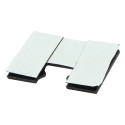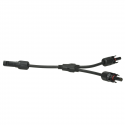O to jak robiłem to bez użycia biblioteki AccelStepper z przykładowym przyciskiem, po którego naciśnięciu uruchamiana była sekwencja
Kod: Zaznacz cały
#include <Servo.h>
Servo myservo;
// define the pins
#define IN1 2
#define IN2 3
#define IN3 4
#define IN4 5
#define button1 6
// define how many cycles to a full rotation
#define CYCLES_PER_ROTATION 512
void setup()
{
Serial.begin(9600);
myservo.attach(9);
myservo.write(40);
pinMode(IN1, OUTPUT);
pinMode(IN2, OUTPUT);
pinMode(IN3, OUTPUT);
pinMode(IN4, OUTPUT);
pinMode(button1, INPUT_PULLUP);
}
void loop()
{
while (digitalRead(button1) == LOW) { // kiedy naciśniemy przycisk 1 uruchamiana jest sekwencja 1
sequence1 ();
}
}
void sequence1 () { // przykładowa sekwencja 1
turns(1.5); // podjedź do punktu
delay(1000);
myservo.write(100); // naciśnij nalewak
delay(3000);
myservo.write(40); // zwolnij nalewak
delay(1000);
turns(-0.5); // podjedź do innego pkt ... itd..
delay(1000);
myservo.write(100);
delay(3000);
myservo.write(40);
delay(1000);
turns(-0.5);
delay(1000);
myservo.write(100);
delay(3000);
myservo.write(40);
delay(1000);
turns(-0.5); // wróć do punktu bazowego
delay(500);
}
void turns(float rotations)
{
// if the rotation count is -ve then it is CCW
Serial.println();
Serial.print("Turning : ");
Serial.print(rotations);
Serial.println(" rotations");
bool clockwise = rotations > 0;
Serial.print("Clockwise = ");
Serial.println(clockwise);
// calculate how many cycles the stepper will have to make
int cycles = rotations * CYCLES_PER_ROTATION;
// force the cycle count to be positive
cycles = abs(cycles);
Serial.print("That is ");
Serial.print(cycles);
Serial.print(" Cycles ");
// only move if the user specifed an actual movement
if(rotations != 0)
{
if (clockwise)
{
Serial.println("Clockwise");
// for each cycle
for (int x=0; x<cycles; x++)
{
// for each phase
for(int y=0; y<8; y++)
{
// go to phase y
phaseSelect(y);
// pause so the stepper has time to react
delay(1);
}
}
} else {
Serial.println("Counter Clockwise");
// for each cycle
for (int x=0; x<cycles; x++)
{
// for each phase (backwards for CCW rotation)
for(int y=7; y>=0; y--)
{
// go to phase y
phaseSelect(y);
// pause so the stepper has time to react
delay(1);
}
}
}
}
// go to the default state (all poles off) when finished
phaseSelect(8);
Serial.println("Done");
}
void phaseSelect(int phase)
{
switch(phase){
case 0:
digitalWrite(IN1, LOW);
digitalWrite(IN2, LOW);
digitalWrite(IN3, LOW);
digitalWrite(IN4, HIGH);
break;
case 1:
digitalWrite(IN1, LOW);
digitalWrite(IN2, LOW);
digitalWrite(IN3, HIGH);
digitalWrite(IN4, HIGH);
break;
case 2:
digitalWrite(IN1, LOW);
digitalWrite(IN2, LOW);
digitalWrite(IN3, HIGH);
digitalWrite(IN4, LOW);
break;
case 3:
digitalWrite(IN1, LOW);
digitalWrite(IN2, HIGH);
digitalWrite(IN3, HIGH);
digitalWrite(IN4, LOW);
break;
case 4:
digitalWrite(IN1, LOW);
digitalWrite(IN2, HIGH);
digitalWrite(IN3, LOW);
digitalWrite(IN4, LOW);
break;
case 5:
digitalWrite(IN1, HIGH);
digitalWrite(IN2, HIGH);
digitalWrite(IN3, LOW);
digitalWrite(IN4, LOW);
break;
case 6:
digitalWrite(IN1, HIGH);
digitalWrite(IN2, LOW);
digitalWrite(IN3, LOW);
digitalWrite(IN4, LOW);
break;
case 7:
digitalWrite(IN1, HIGH);
digitalWrite(IN2, LOW);
digitalWrite(IN3, LOW);
digitalWrite(IN4, HIGH);
break;
default:
digitalWrite(IN1, LOW);
digitalWrite(IN2, LOW);
digitalWrite(IN3, LOW);
digitalWrite(IN4, LOW);
break;
}
}
Chodzi mi o to, aby przerobić go w ten sposób, by silnik krokowy rozpędzał i wyhamowywał wózek.
Będę wdzięczny za każdą pomoc
Pozdrawiam!
















